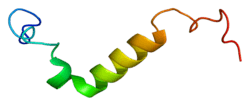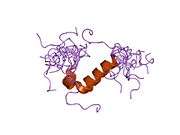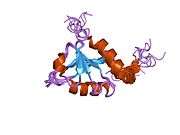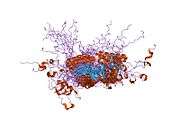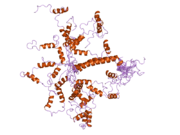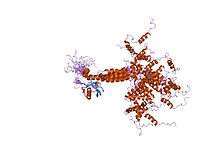PSMD4
26S proteasome non-ATPase regulatory subunit 4, also as known as 26S Proteasome Regulatory Subunit Rpn10 (systematic nomenclature), is an enzyme that in humans is encoded by the PSMD4 gene.[5][6] This protein is one of the 19 essential subunits that contributes to the complete assembly of 19S proteasome complex.[7]
Gene
The gene PSMD4 encodes one of the non-ATPase subunits of the 19S regulator base, subunit Rpn10. Pseudogenes have been identified on chromosomes 10 and 21.[6] The human PSMD4 gene has 10 exons and locates at chromosome band 1q21.3.
Protein
The human protein 26S proteasome non-ATPase regulatory subunit 4 is 41 kDa in size and composed of 377 amino acids. The calculated theoretical pI of this protein is 4.68. An alternative splicing during gene expression generates an isoform of the protein in which the amino acid sequence from 269-377 is missing while the amino sequence between 255-268 is replaced from DSDDALLKMTISQQ to GERGGIRSPGTAGC.[8]
Complex assembly
26S proteasome complex is usually consisted of a 20S core particle (CP, or 20S proteasome) and one or two 19S regulatory particles (RP, or 19S proteasome) on either one side or both side of the barrel-shaped 20S. The CP and RPs pertain distinct structural characteristics and biological functions. In brief, 20S sub complex presents three types proteolytic activities, including caspase-like, trypsin-like, and chymotrypsin-like activities. These proteolytic active sites located in the inner side of a chamber formed by 4 stacked rings of 20S subunits, preventing random protein-enzyme encounter and uncontrolled protein degradation. The 19S regulatory particles can recognize ubiquitin-labeled protein as degradation substrate, unfold the protein to linear, open the gate of 20S core particle, and guide the substate into the proteolytic chamber. To meet such functional complexity, 19S regulatory particle contains at least 18 constitutive subunits. These subunits can be categorized into two classes based on the ATP dependence of subunits, ATP-dependent subunits and ATP-independent subunits. According to the protein interaction and topological characteristics of this multisubunit complex, the 19S regulatory particle is composed of a base and a lid subcomplex. The base consists of a ring of six AAA ATPases (Subunit Rpt1-6, systematic nomenclature) and four non-ATPase subunits (Rpn1, Rpn2, Rpn10, and Rpn13). Thus, protein 26S proteasome non-ATPase regulatory subunit 2 (Rpn1) is an essential component of forming the base subcomplex of 19S regulatory particle. Traditionally, Rpn10 were considered residing between the base subcomplex and the lid subcomplex. However, recent investigation provides an alternative structure of 19S base via an integrative approach combining data from cryoelectron microscopy, X-ray crystallography, residue-specific chemical cross-linking, and several proteomics techniques. Rpn2 is rigid protein located on the side of ATPase ring, supporting as the connection between the lid and base. Rpn1 is conformationally variable, positioned at the periphery of the ATPase ring. The ubiquitin receptors Rpn10 and Rpn13 are located further in the distal part of the 19S complex, indicating that they were recruited to the complex late during the assembly process.[9]
Function
As the degradation machinery that is responsible for ~70% of intracellular proteolysis,[10] proteasome complex (26S proteasome) plays a critical roles in maintaining the homeostasis of cellular proteome. Accordingly, misfolded proteins and damaged protein need to be continuously removed to recycle amino acids for new synthesis; in parallel, some key regulatory proteins fulfill their biological functions via selective degradation; furthermore, proteins are digested into peptides for MHC class I antigen presentation. To meet such complicated demands in biological process via spatial and temporal proteolysis, protein substrates have to be recognized, recruited, and eventually hydrolyzed in a well controlled fashion. Thus, 19S regulatory particle pertains a series of important capabilities to address these functional challenges. To recognize protein as designated substrate, 19S complex has subunits that are capable to recognize proteins with a special degradative tag, the ubiquitinylation. It also has subunits that can bind with nucleotides (e.g., ATPs) in order to facilitate the association between 19S and 20S particles, as well as to cause confirmation changes of alpha subunit C-terminals that form the substate entrance of 20S complex. Rpn10 is one essential subunit of 19S regulatory particle and it contributes to the assembly of the "base" subcomplex. In the base sub complex, Rpn1 offers a docking position for subunit Rpn10 at its central solenoid portion, although such association with Rpn10 is stabilized by a third subunit, Rpn2.[11] Rpn10 serve as a receptor for poly-ubiquitylated protein substrates.[11][12]
Clinical significance
The proteasome and its subunits are of clinical significance for at least two reasons: (1) a compromised complex assembly or a dysfunctional proteasome can be associated with the underlying pathophysiology of specific diseases, and (2) they can be exploited as drug targets for therapeutic interventions. More recently, more effort has been made to consider the proteasome for the development of novel diagnostic markers and strategies. An improved and comprehensive understanding of the pathophysiology of the proteasome should lead to clinical applications in the future.
The proteasomes form a pivotal component for the ubiquitin–proteasome system (UPS) [13] and corresponding cellular Protein Quality Control (PQC). Protein ubiquitination and subsequent proteolysis and degradation by the proteasome are important mechanisms in the regulation of the cell cycle, cell growth and differentiation, gene transcription, signal transduction and apoptosis.[14] Subsequently, a compromised proteasome complex assembly and function lead to reduced proteolytic activities and the accumulation of damaged or misfolded protein species. Such protein accumulation may contribute to the pathogenesis and phenotypic characteristics in neurodegenerative diseases,[15][16] cardiovascular diseases,[17][18][19] inflammatory responses and autoimmune diseases,[20] and systemic DNA damage responses leading to malignancies.[21]
Several experimental and clinical studies have indicated that aberrations and deregulations of the UPS contribute to the pathogenesis of several neurodegenerative and myodegenerative disorders, including Alzheimer's disease,[22] Parkinson's disease[23] and Pick's disease,[24] Amyotrophic lateral sclerosis (ALS),[24] Huntington's disease,[23] Creutzfeldt–Jakob disease,[25] and motor neuron diseases, polyglutamine (PolyQ) diseases, Muscular dystrophies[26] and several rare forms of neurodegenerative diseases associated with dementia.[27] As part of the ubiquitin–proteasome system (UPS), the proteasome maintains cardiac protein homeostasis and thus plays a significant role in cardiac ischemic injury,[28] ventricular hypertrophy[29] and heart failure.[30] Additionally, evidence is accumulating that the UPS plays an essential role in malignant transformation. UPS proteolysis plays a major role in responses of cancer cells to stimulatory signals that are critical for the development of cancer. Accordingly, gene expression by degradation of transcription factors, such as p53, c-jun, c-Fos, NF-κB, c-Myc, HIF-1α, MATα2, STAT3, sterol-regulated element-binding proteins and androgen receptors are all controlled by the UPS and thus involved in the development of various malignancies.[31] Moreover, the UPS regulates the degradation of tumor suppressor gene products such as adenomatous polyposis coli (APC) in colorectal cancer, retinoblastoma (Rb). and von Hippel–Lindau tumor suppressor (VHL), as well as a number of proto-oncogenes (Raf, Myc, Myb, Rel, Src, Mos, ABL). The UPS is also involved in the regulation of inflammatory responses. This activity is usually attributed to the role of proteasomes in the activation of NF-κB which further regulates the expression of pro inflammatory cytokines such as TNF-α, IL-β, IL-8, adhesion molecules (ICAM-1, VCAM-1, P-selectin) and prostaglandins and nitric oxide (NO).[20] Additionally, the UPS also plays a role in inflammatory responses as regulators of leukocyte proliferation, mainly through proteolysis of cyclines and the degradation of CDK inhibitors.[32] Lastly, autoimmune disease patients with SLE, Sjögren syndrome and rheumatoid arthritis (RA) predominantly exhibit circulating proteasomes which can be applied as clinical biomarkers.[33]
Interactions
PSMD4 has been shown to interact with RAD23A[34][35] and RAD23B.[34]
References
- GRCh38: Ensembl release 89: ENSG00000159352 - Ensembl, May 2017
- GRCm38: Ensembl release 89: ENSMUSG00000005625 - Ensembl, May 2017
- "Human PubMed Reference:". National Center for Biotechnology Information, U.S. National Library of Medicine.
- "Mouse PubMed Reference:". National Center for Biotechnology Information, U.S. National Library of Medicine.
- Ferrell K, Deveraux Q, van Nocker S, Rechsteiner M (Jul 1996). "Molecular cloning and expression of a multiubiquitin chain binding subunit of the human 26S protease". FEBS Lett. 381 (1–2): 143–8. doi:10.1016/0014-5793(96)00101-9. PMID 8641424.
- "Entrez Gene: PSMD4 proteasome (prosome, macropain) 26S subunit, non-ATPase, 4".
- Gu ZC, Enenkel C (Dec 2014). "Proteasome assembly". Cellular and Molecular Life Sciences. 71 (24): 4729–45. doi:10.1007/s00018-014-1699-8. PMID 25107634.
- "Uniprot : P55036 - PSMD4_HUMAN".
- Lasker K, Förster F, Bohn S, Walzthoeni T, Villa E, Unverdorben P, Beck F, Aebersold R, Sali A, Baumeister W (Jan 2012). "Molecular architecture of the 26S proteasome holocomplex determined by an integrative approach". Proceedings of the National Academy of Sciences of the United States of America. 109 (5): 1380–7. Bibcode:2012PNAS..109.1380L. doi:10.1073/pnas.1120559109. PMC 3277140. PMID 22307589.
- Rock KL, Gramm C, Rothstein L, Clark K, Stein R, Dick L, Hwang D, Goldberg AL (Sep 1994). "Inhibitors of the proteasome block the degradation of most cell proteins and the generation of peptides presented on MHC class I molecules". Cell. 78 (5): 761–71. doi:10.1016/s0092-8674(94)90462-6. PMID 8087844.
- Rosenzweig R, Bronner V, Zhang D, Fushman D, Glickman MH (Apr 2012). "Rpn1 and Rpn2 coordinate ubiquitin processing factors at proteasome". The Journal of Biological Chemistry. 287 (18): 14659–71. doi:10.1074/jbc.M111.316323. PMC 3340268. PMID 22318722.
- Sakata E, Bohn S, Mihalache O, Kiss P, Beck F, Nagy I, Nickell S, Tanaka K, Saeki Y, Förster F, Baumeister W (Jan 2012). "Localization of the proteasomal ubiquitin receptors Rpn10 and Rpn13 by electron cryomicroscopy". Proceedings of the National Academy of Sciences of the United States of America. 109 (5): 1479–84. Bibcode:2012PNAS..109.1479S. doi:10.1073/pnas.1119394109. PMC 3277190. PMID 22215586.
- Kleiger G, Mayor T (Jun 2014). "Perilous journey: a tour of the ubiquitin–proteasome system". Trends in Cell Biology. 24 (6): 352–9. doi:10.1016/j.tcb.2013.12.003. PMC 4037451. PMID 24457024.
- Goldberg AL, Stein R, Adams J (Aug 1995). "New insights into proteasome function: from archaebacteria to drug development". Chemistry & Biology. 2 (8): 503–8. doi:10.1016/1074-5521(95)90182-5. PMID 9383453.
- Sulistio YA, Heese K (Jan 2015). "The Ubiquitin–Proteasome System and Molecular Chaperone Deregulation in Alzheimer's Disease". Molecular Neurobiology. 53 (2): 905–31. doi:10.1007/s12035-014-9063-4. PMID 25561438.
- Ortega Z, Lucas JJ (2014). "Ubiquitin-proteasome system involvement in Huntington's disease". Frontiers in Molecular Neuroscience. 7: 77. doi:10.3389/fnmol.2014.00077. PMC 4179678. PMID 25324717.
- Sandri M, Robbins J (Jun 2014). "Proteotoxicity: an underappreciated pathology in cardiac disease". Journal of Molecular and Cellular Cardiology. 71: 3–10. doi:10.1016/j.yjmcc.2013.12.015. PMC 4011959. PMID 24380730.
- Drews O, Taegtmeyer H (Dec 2014). "Targeting the ubiquitin-proteasome system in heart disease: the basis for new therapeutic strategies". Antioxidants & Redox Signaling. 21 (17): 2322–43. doi:10.1089/ars.2013.5823. PMC 4241867. PMID 25133688.
- Wang ZV, Hill JA (Feb 2015). "Protein quality control and metabolism: bidirectional control in the heart". Cell Metabolism. 21 (2): 215–26. doi:10.1016/j.cmet.2015.01.016. PMC 4317573. PMID 25651176.
- Karin M, Delhase M (Feb 2000). "The I kappa B kinase (IKK) and NF-kappa B: key elements of proinflammatory signalling". Seminars in Immunology. 12 (1): 85–98. doi:10.1006/smim.2000.0210. PMID 10723801.
- Ermolaeva MA, Dakhovnik A, Schumacher B (Jan 2015). "Quality control mechanisms in cellular and systemic DNA damage responses". Ageing Research Reviews. 23 (Pt A): 3–11. doi:10.1016/j.arr.2014.12.009. PMC 4886828. PMID 25560147.
- Checler F, da Costa CA, Ancolio K, Chevallier N, Lopez-Perez E, Marambaud P (Jul 2000). "Role of the proteasome in Alzheimer's disease". Biochimica et Biophysica Acta (BBA) - Molecular Basis of Disease. 1502 (1): 133–8. doi:10.1016/s0925-4439(00)00039-9. PMID 10899438.
- Chung KK, Dawson VL, Dawson TM (Nov 2001). "The role of the ubiquitin-proteasomal pathway in Parkinson's disease and other neurodegenerative disorders". Trends in Neurosciences. 24 (11 Suppl): S7–14. doi:10.1016/s0166-2236(00)01998-6. PMID 11881748.
- Ikeda K, Akiyama H, Arai T, Ueno H, Tsuchiya K, Kosaka K (Jul 2002). "Morphometrical reappraisal of motor neuron system of Pick's disease and amyotrophic lateral sclerosis with dementia". Acta Neuropathologica. 104 (1): 21–8. doi:10.1007/s00401-001-0513-5. PMID 12070660.
- Manaka H, Kato T, Kurita K, Katagiri T, Shikama Y, Kujirai K, Kawanami T, Suzuki Y, Nihei K, Sasaki H (May 1992). "Marked increase in cerebrospinal fluid ubiquitin in Creutzfeldt–Jakob disease". Neuroscience Letters. 139 (1): 47–9. doi:10.1016/0304-3940(92)90854-z. PMID 1328965.
- Mathews KD, Moore SA (Jan 2003). "Limb-girdle muscular dystrophy". Current Neurology and Neuroscience Reports. 3 (1): 78–85. doi:10.1007/s11910-003-0042-9. PMID 12507416.
- Mayer RJ (Mar 2003). "From neurodegeneration to neurohomeostasis: the role of ubiquitin". Drug News & Perspectives. 16 (2): 103–8. doi:10.1358/dnp.2003.16.2.829327. PMID 12792671.
- Calise J, Powell SR (Feb 2013). "The ubiquitin proteasome system and myocardial ischemia". American Journal of Physiology. Heart and Circulatory Physiology. 304 (3): H337–49. doi:10.1152/ajpheart.00604.2012. PMC 3774499. PMID 23220331.
- Predmore JM, Wang P, Davis F, Bartolone S, Westfall MV, Dyke DB, Pagani F, Powell SR, Day SM (Mar 2010). "Ubiquitin proteasome dysfunction in human hypertrophic and dilated cardiomyopathies". Circulation. 121 (8): 997–1004. doi:10.1161/CIRCULATIONAHA.109.904557. PMC 2857348. PMID 20159828.
- Powell SR (Jul 2006). "The ubiquitin-proteasome system in cardiac physiology and pathology". American Journal of Physiology. Heart and Circulatory Physiology. 291 (1): H1–H19. doi:10.1152/ajpheart.00062.2006. PMID 16501026.
- Adams J (Apr 2003). "Potential for proteasome inhibition in the treatment of cancer". Drug Discovery Today. 8 (7): 307–15. doi:10.1016/s1359-6446(03)02647-3. PMID 12654543.
- Ben-Neriah Y (Jan 2002). "Regulatory functions of ubiquitination in the immune system". Nature Immunology. 3 (1): 20–6. doi:10.1038/ni0102-20. PMID 11753406.
- Egerer K, Kuckelkorn U, Rudolph PE, Rückert JC, Dörner T, Burmester GR, Kloetzel PM, Feist E (Oct 2002). "Circulating proteasomes are markers of cell damage and immunologic activity in autoimmune diseases". The Journal of Rheumatology. 29 (10): 2045–52. PMID 12375310.
- Hiyama H, Yokoi M, Masutani C, Sugasawa K, Maekawa T, Tanaka K, Hoeijmakers JH, Hanaoka F (Sep 1999). "Interaction of hHR23 with S5a. The ubiquitin-like domain of hHR23 mediates interaction with S5a subunit of 26 S proteasome". J. Biol. Chem. 274 (39): 28019–25. doi:10.1074/jbc.274.39.28019. PMID 10488153.
- Mueller TD, Feigon J (Sep 2003). "Structural determinants for the binding of ubiquitin-like domains to the proteasome". EMBO J. 22 (18): 4634–45. doi:10.1093/emboj/cdg467. PMC 212733. PMID 12970176.
Further reading
- Coux O, Tanaka K, Goldberg AL (1996). "Structure and functions of the 20S and 26S proteasomes". Annu. Rev. Biochem. 65: 801–47. doi:10.1146/annurev.bi.65.070196.004101. PMID 8811196.
- Goff SP (2003). "Death by deamination: a novel host restriction system for HIV-1". Cell. 114 (3): 281–3. doi:10.1016/S0092-8674(03)00602-0. PMID 12914693.
- Lönnroth I, Lange S (1986). "Purification and characterization of the antisecretory factor: a protein in the central nervous system and in the gut which inhibits intestinal hypersecretion induced by cholera toxin". Biochim. Biophys. Acta. 883 (1): 138–44. doi:10.1016/0304-4165(86)90144-3. PMID 3524692.
- Johansson E, Lönnroth I, Lange S, Jonson I, Jennische E, Lönnroth C (1995). "Molecular cloning and expression of a pituitary gland protein modulating intestinal fluid secretion". J. Biol. Chem. 270 (35): 20615–20. doi:10.1074/jbc.270.35.20615. PMID 7657640.
- Seeger M, Ferrell K, Frank R, Dubiel W (1997). "HIV-1 tat inhibits the 20 S proteasome and its 11 S regulator-mediated activation". J. Biol. Chem. 272 (13): 8145–8. doi:10.1074/jbc.272.13.8145. PMID 9079628.
- Anand G, Yin X, Shahidi AK, Grove L, Prochownik EV (1997). "Novel regulation of the helix-loop-helix protein Id1 by S5a, a subunit of the 26 S proteasome". J. Biol. Chem. 272 (31): 19140–51. doi:10.1074/jbc.272.31.19140. PMID 9235903.
- Young P, Deveraux Q, Beal RE, Pickart CM, Rechsteiner M (1998). "Characterization of two polyubiquitin binding sites in the 26 S protease subunit 5a". J. Biol. Chem. 273 (10): 5461–7. doi:10.1074/jbc.273.10.5461. PMID 9488668.
- Madani N, Kabat D (1998). "An endogenous inhibitor of human immunodeficiency virus in human lymphocytes is overcome by the viral Vif protein". J. Virol. 72 (12): 10251–5. doi:10.1128/JVI.72.12.10251-10255.1998. PMC 110608. PMID 9811770.
- Simon JH, Gaddis NC, Fouchier RA, Malim MH (1998). "Evidence for a newly discovered cellular anti-HIV-1 phenotype". Nat. Med. 4 (12): 1397–400. doi:10.1038/3987. PMID 9846577.
- Hiyama H, Yokoi M, Masutani C, Sugasawa K, Maekawa T, Tanaka K, Hoeijmakers JH, Hanaoka F (1999). "Interaction of hHR23 with S5a. The ubiquitin-like domain of hHR23 mediates interaction with S5a subunit of 26 S proteasome". J. Biol. Chem. 274 (39): 28019–25. doi:10.1074/jbc.274.39.28019. PMID 10488153.
- Tateishi K, Misumi Y, Ikehara Y, Miyasaka K, Funakoshi A (1999). "Molecular cloning and expression of rat antisecretory factor and its intracellular localization". Biochem. Cell Biol. 77 (3): 223–8. doi:10.1139/bcb-77-3-223. PMID 10505793.
- Tanahashi N, Murakami Y, Minami Y, Shimbara N, Hendil KB, Tanaka K (2000). "Hybrid proteasomes. Induction by interferon-gamma and contribution to ATP-dependent proteolysis". J. Biol. Chem. 275 (19): 14336–45. doi:10.1074/jbc.275.19.14336. PMID 10799514.
- Mulder LC, Muesing MA (2000). "Degradation of HIV-1 integrase by the N-end rule pathway". J. Biol. Chem. 275 (38): 29749–53. doi:10.1074/jbc.M004670200. PMID 10893419.
- Kawahara H, Kasahara M, Nishiyama A, Ohsumi K, Goto T, Kishimoto T, Saeki Y, Yokosawa H, Shimbara N, Murata S, Chiba T, Suzuki K, Tanaka K (2000). "Developmentally regulated, alternative splicing of the Rpn10 gene generates multiple forms of 26S proteasomes". EMBO J. 19 (15): 4144–53. doi:10.1093/emboj/19.15.4144. PMC 306610. PMID 10921894.
- Connell P, Ballinger CA, Jiang J, Wu Y, Thompson LJ, Höhfeld J, Patterson C (2001). "The co-chaperone CHIP regulates protein triage decisions mediated by heat-shock proteins". Nat. Cell Biol. 3 (1): 93–6. doi:10.1038/35050618. PMID 11146632.
- Kamitani T, Kito K, Fukuda-Kamitani T, Yeh ET (2002). "Targeting of NEDD8 and its conjugates for proteasomal degradation by NUB1". J. Biol. Chem. 276 (49): 46655–60. doi:10.1074/jbc.M108636200. PMID 11585840.
- Walters KJ, Kleijnen MF, Goh AM, Wagner G, Howley PM (2002). "Structural studies of the interaction between ubiquitin family proteins and proteasome subunit S5a". Biochemistry. 41 (6): 1767–77. doi:10.1021/bi011892y. PMID 11827521.
- Sheehy AM, Gaddis NC, Choi JD, Malim MH (2002). "Isolation of a human gene that inhibits HIV-1 infection and is suppressed by the viral Vif protein". Nature. 418 (6898): 646–50. Bibcode:2002Natur.418..646S. doi:10.1038/nature00939. PMID 12167863.
